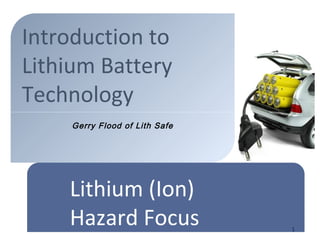
NASA Presentation
- 1. Introduction to Lithium Battery Technology 1 Lithium (Ion) Hazard Focus Gerry Flood of Lith Safe
- 2. 2 Battery Features Battery Chemistry Lithium Metal (Primary) Benefits/Drawbacks •Used one time •Discarded after use •Long shelf life •Lower self-discharge •High energy density
- 3. 3 Battery Features Battery Chemistry Lithium Ion (Secondary) Benefits •Rechargeable •Cost advantages (long term)
- 4. 4 Battery Features Battery Chemistry Lithium Ion (Secondary) Benefits •Largest energy density •High electrochemical potential •Low maintenance •Low self-discharge
- 5. 5 Battery Features Battery Chemistry Lithium Ion (Secondary) Drawbacks •Considerable fire potential •Requires safety circuitry •Questionable tolerance for aging •Transportation and storage restrictions
- 6. Battery Features 6 Lithium (Ion) Focus They have a negatively charged Carbon anode, a positively-charged Metal Oxyde Cathode and Lithium Ion Compound as electrolyte. Lithium Ion Batteries run down and require recharging. Lithium Ion Automotive batteries hold a large amount of potential energy!
- 7. Battery Failure and Thermal Runaway 7 Lithium (Ion) Focus
- 10. 10 Battery Failure Energetic Battery Failure The Anatomy of Thermal Runaway Propagation
- 11. 11 Battery Failure Lithium metal deposits Lithium Ion cellEnergetic Battery Failure Electrical Abuse •Lithium plating a) A chemical/electrical process that basically transforms free lithium ions into lithium metal (deposits). a) Fire and explosion risks grow substantially
- 12. Battery Fire Behavior 12 Lithium (Ion) Focus
- 13. 13 Battery Fire Behavior Battery Fire Classes Batteries can be “multi-classed” with some fitting comfortably into ALL four common classes!
- 14. 14 Battery Fire Behavior Battery Fire Classes Lithium (Primary) •Combustible build materials (A) •Combustible metals (D) •Possibly energized (C)
- 15. 15 Battery Fire Behavior Battery Fire Classes Lithium Ion (Secondary) •Combustible build materials (A) •Flammable Electrolyte (B) •Possibly energized (C) Question: Can Lithium Plating add a “Combustible metals” component?
- 16. 16 Battery Fire Behavior Battery Fire Classes Class A – Water works Best Class B- Smother Effects on flammable liquid, venting gases, N2 possible Class C - Non Conductive Agent, CO2 Class D – Metals, Dry Powder, Sand
- 17. 17 Battery Fire Behavior Composed of many “ordinary combustible” materials Battery Fire Classes Question: Why are lithium (ion) batteries not limited to any one class of fire?
- 18. 18 Battery Fire Behavior Battery Fire Classes Question: Why are lithium (ion) batteries not limited to any one class of fire? Contain flammable liquids in electrolyte form
- 19. 19 Battery Fire Behavior Battery Fire Classes Question: Why are lithium (ion) batteries not limited to any one class of fire? May possess an electrical shock hazard
- 20. 20 Battery Fire Behavior Battery Fire Classes Question: Why are lithium (ion) batteries not limited to any one class of fire? Lithium (primary) cells possess combustible metals
- 21. 21 Battery Fire Behavior Battery Fire Properties Question: What are the properties of Lithium (ion) cell burn? Gas release (burn and no burn) Severe: •Skin burn •Eye irritation •Respiratory issues •Disorientation
- 22. 22 Battery Fire Behavior Battery Fire Classes Question: What are the properties of Lithium (ion) cell burn? •Hydrogen •Carbon dioxide •Carbon monoxide •Methane •Ethylene •Ethane •Propylene Source: Sandia National Labs. Gas release during cell venting.
- 23. 23 EUCAR Hazard Levels (European Council for Automotive Research) Hazard Level Description Classification Criteria 0 No effect No effect. No loss of functionality 1 Passive protection activated No defect; no leakage; no venting fire or flame; no rupture; no explosion; no exothermic reaction or thermal runaway. Cell irreversibly damaged. Repair is needed. 2 Defect / Damage No leakage; no venting fire or flame; no rupture; no explosion; no exothermic reaction or thermal runaway. Cell irreversibly damaged. Repair is needed. 3 Leakage Δ mass < 50% No venting, fire or flame*; no rupture; no explosion. Weight loss < 50% of electrolyte weight (electrolyte = solvent + salt) 4 Venting Δ mass ≥ 50% No fire or flame*; no rupture; no explosion. Weight loss ≥ 50% of electrolyte weight (electrolyte = solvent + salt) 5 Fire or Flame No rupture; no explosion (i.e., no flying parts) 6 Rupture No explosion, but flying parts of the active mass 7 Explosion Explosion (i.e., disintegration of the cell)
- 24. 24 Battery Fire Suppression Suppression Methodology Remember:
- 25. Thank You! 25
